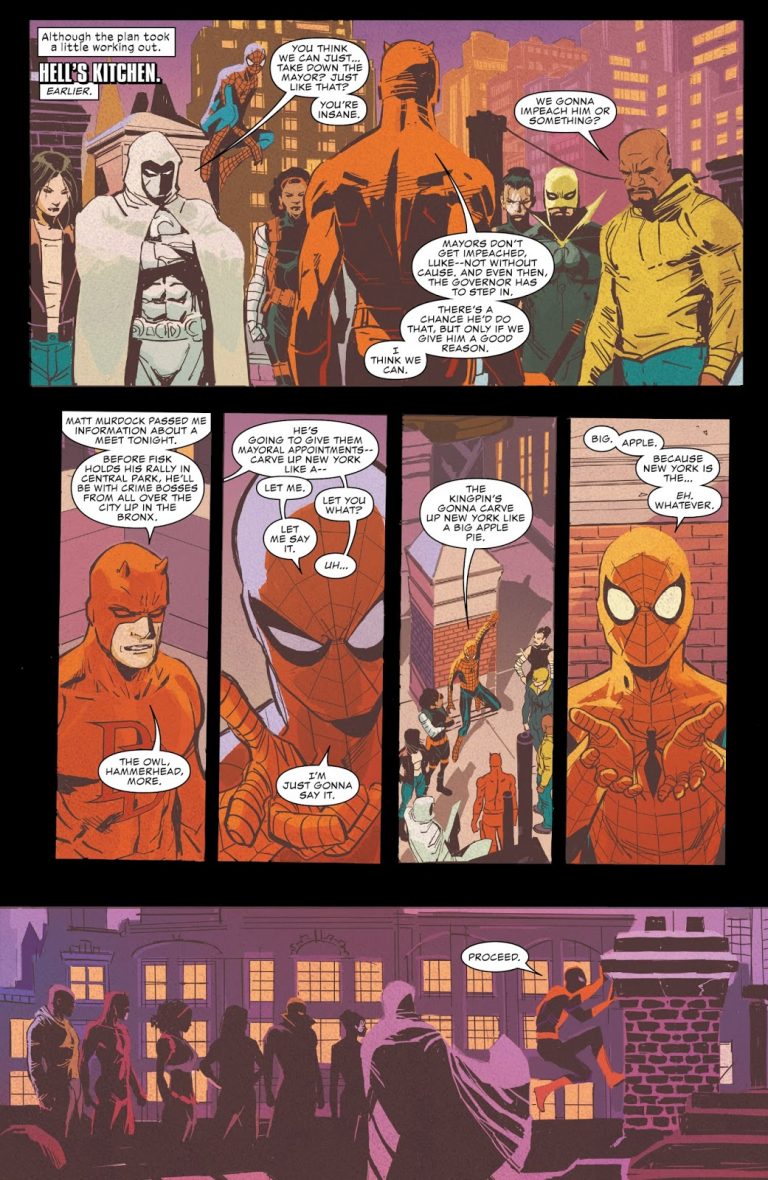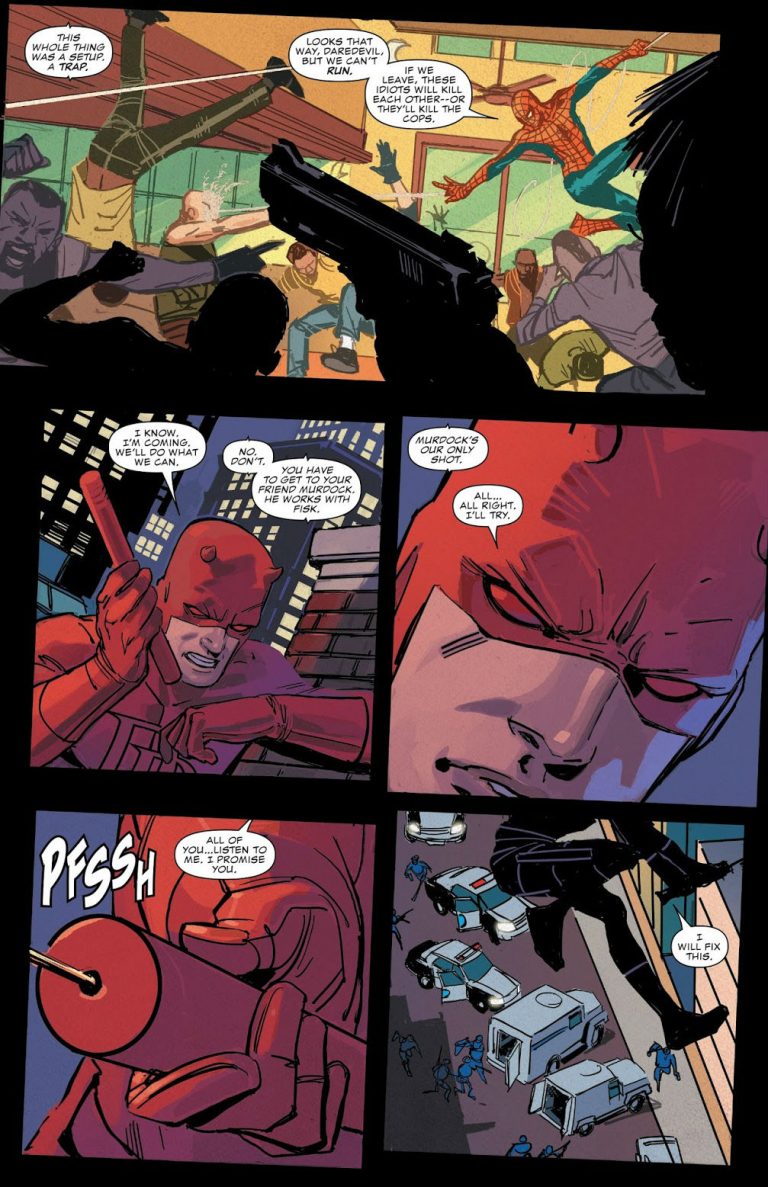By Don Alsafi. Twenty years ago, no one had heard of Daredevil.
Comics fans knew him, of course, especially after Frank Miller’s seminal 1980s run entirely revitalized the character. But mainstream audiences wouldn’t know the name Matt Murdock until the 2003 film – which was, all told, a bit of a mixed bag. Not that expectation was sky-high at this point; Bryan Singer’s X-Men had shown that superhero films could be done right, but we were still five years out from Iron Man kickstarting the MCU, and its resulting crop of largely excellent action movies.
But in April 2015, Netflix released the first season of its Daredevil television show – and instantly, character awareness reached an unprecedented (and previously unthinkable) high. Its third season is currently in development, and DD also starred in Netflix’s team-up series The Defenders. More people are thrilling to his adventures today than perhaps have ever done so before!
Of course, the question for Marvel Publishing is how to translate that brand awareness into more people picking up his comic. You can have the average consumer walk in off the street and pick up the latest issue of Daredevil off the rack – but how well will that capture their imagination? How might that succeed, or fail, based on the creative team’s combined efforts?
Well, there’s a great big honking #600 on its cover this week. Let’s give it a read and find out!
Written by Charles Soule.
Art by Ron Garney.
Colors by Matt Milla.
Backup story by Christos Gage, Mike Perkins and Andy Troy.
Letters by VC’s Clayton Cowles.
Massive changes, and massive suspense. Wilson Fisk, the Kingpin of Crime, is now Mayor of New York City.
As changes to the status quo are measured? That’s pretty huge. It even trumps that time when Spider-Man came back from two months in the Negative Zone to find that NYC’s mayor was none other than perennial thorn-in-his-side J. Jonah Jameson. (Seriously, what are New York voters doing?) But J.J.J. was rarely more than a hassle to Peter Parker. Fisk, on the other hand, has been on the wrong side of the law for a long, long time. He is crafty, and he is powerful, and he is driven.
And now he makes the law. He commands the NYPD. And he’s even gone so far as to declare superheroes illegal.
Even stranger: Fisk has appointed Matt Murdock as the Deputy Mayor, as a way of keeping him under tabs. (Does Fisk still know Matt is Daredevil? His secret identity was outed during the Bendis run, but that’s since been bottled up again…) One has to assume Matt initially balked at the suggestion, before deciding there was no better place to likewise keep an eye on Fisk.
Oh, and there’s an Inhuman serial killer on the loose.
And all that? That’s where this month’s story just begins…! It’s certainly an impressive clash of enmities, dire threats, and mounting dread – and the exact place you want your anniversary milestone issue to kick off.

Interior page from ‘Daredevil’ #600. Art by Ron Garney, Matt Milla, and Clayton Cowles/Marvel Comics
High stakes, masterful pace. Charles Soule has been writing Daredevil for the past two years, and was an inspired choice. Not only has his comics work won him increasing acclaim, but he’s also been a practicing attorney himself – experience he also made use of in 2014 when writing Marvel’s other superhero/lawyer book, She-Hulk. There isn’t a courtroom scene in the entire 30-page lead story here, but Soule’s eye for the big picture can nevertheless be seen, as multiple long-running threads seemingly come together at once.
As the story opens, Daredevil has gathered a host of his street-level colleagues (Spider-Man, Luke Cage, Moon Knight, etc.) to bust up a meeting of some of New York’s major crime lords – a meeting which Fisk himself has set up. Some of the heroes just want to charge in and bust heads, but Matt is a thinker. He’s meticulous. He’s got a larger plan than just throwing a couple of bad guys in jail. But things don’t go as badly as you might expect!
They actually go much worse.
In fact, one of the strengths of the book is that meticulously-planned pacing. The opening segments utterly bristle with tension. The heroes know how bad things have gotten, and what’s at stake – and, thanks to Soule’s unobtrusive exposition, readers do as well. A confrontation between Fisk and Daredevil would, in any other book, be the expected climax. And it is! But that’s quickly forgotten by the advent of not one but two fairly shocking plot twists in quick succession. And by issue’s end the landscape has changed. Again.

Interior page from ‘Daredevil’ #600. Art by Ron Garney, Matt Milla, and Clayton Cowles/Marvel Comics
Dark and moody, and a bit trippy too. Instrumental in this issue’s success is the richly compelling artwork of Ron Garney, who has been illustrating superhero comics since the early ’90s. His work has always had a pleasingly classic feel to it, which lent itself well to runs on books like Captain America and Silver Surfer. Here, though, his art seems to have evolved, possibly as a result of Marvel’s recent trend to have books illustrated by one artist, rather than the traditional penciller/inker team. Garney’s artwork thus has more of a looser, slightly rougher feel than before – but on a gritty, street-level book like Daredevil, it totally works.
Matt Milla’s colors also deserve special attention. The tale begins on a rooftop at dusk, and Milla’s hues effectively paint the sickly half-lit glow of the setting sun and its darkening shadows. Most impressive though are the couple of times we glimpse Matt’s radar sense; clashing neon shades and a lack of black linework instantly convey a visual shorthand that seems to half suggest a photographic negative, and half… something else. The radar sense has been portrayed a number of different ways over the years, but the colors alone make this depiction one of the more memorable.

Interior page from ‘Daredevil’ #600. Art by Ron Garney, Matt Milla, and Clayton Cowles/Marvel Comics
Quibbles aside? It’s a remarkable book. The slow-build tension that permeates much of this story is noteworthy – and if the issue isn’t completely perfect, it’s still pretty close. A third of the comic is intercut with a violent confrontation between the Inhuman serial killer and another new character, Blindspot. It’s necessary for the eleventh-hour twist that’s to come, but the A-story is so exciting and compelling that this extended fight scene between side characters does drag the momentum slightly.
There’s also an 8-page backup story written by Christos Gage. The artwork by Mike Perkins is gorgeous, and shows Matt Murdock and Foggy Nelson over the years, and how their friendship has seen them through good times and bad. Unfortunately, this plays out as a rapid sequence of snapshots without a lot of weight or context to them, and thus ends up feeling even more extraneous than most backup stories tend to do. It’s not bad, really – but after the truly excellent main tale, it does regrettably deflate the whole, and right at the end. (If Marvel wanted to justify the $5.99 price tag, perhaps giving those eight pages back to the lead story would have been more effective. That paid massive dividends on The Mighty Thor #700, after all!)
But at the end of the day those are niggling complaints in a six-hundredth issue story that, in every other way, entirely delivers. With what Charles Soule and Ron Garney have put to the page, Daredevil remains in capable hands.
Good thing, too. Because where the events of this issue leave off? He’s gonna need all the help he can get.
8.5 out of 10














